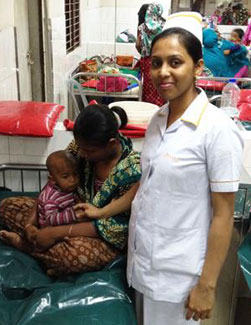Child dehydration diagnostic tool validated
September / October 2016 | Volume 15, Number 5

Photo courtesy of Dr. Adam Levine
Nurse Ilishabeth Samadder sees many young
children at the International Centre for
Diarrhoeal Disease Research in Bangladesh.
A method of diagnosing the severity of dehydration in children has been validated by a team of scientists at Brown University.
As many as 700,000 children die worldwide each year of dehydration, making the quick and accurate diagnostic tool particularly useful in low-resource settings.
Developed in Bangladesh and known as the DHAKA score, diagnosis is based on four symptoms:
- General appearance: is the child restless, irritable, lethargic or unconscious?
- Breathing: is it normal or deep?
- Skin pinch: after a pinch, does skin snap back, respond slowly or very slowly?
- Tears: does the child produce normal volume, less than normal or none?
More Information
To view Adobe PDF files,
download current, free accessible plug-ins from Adobe's website.